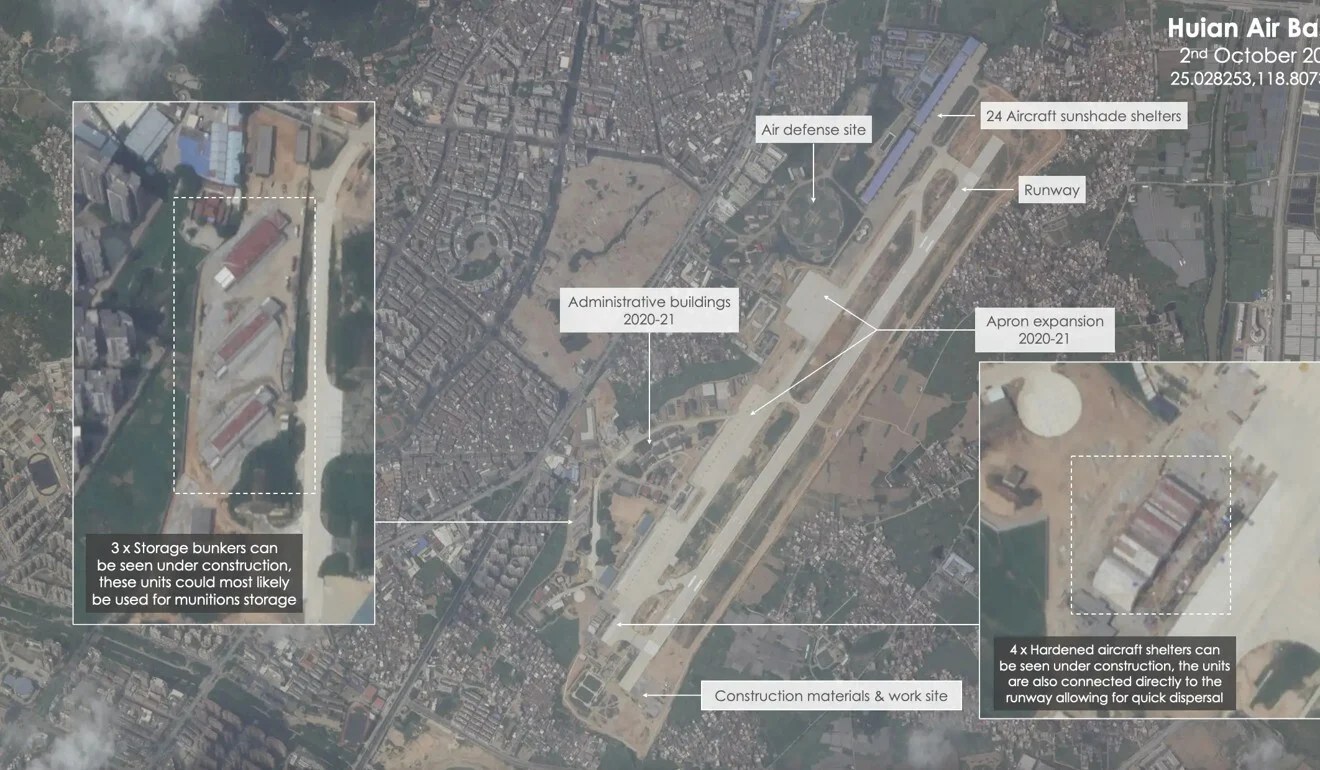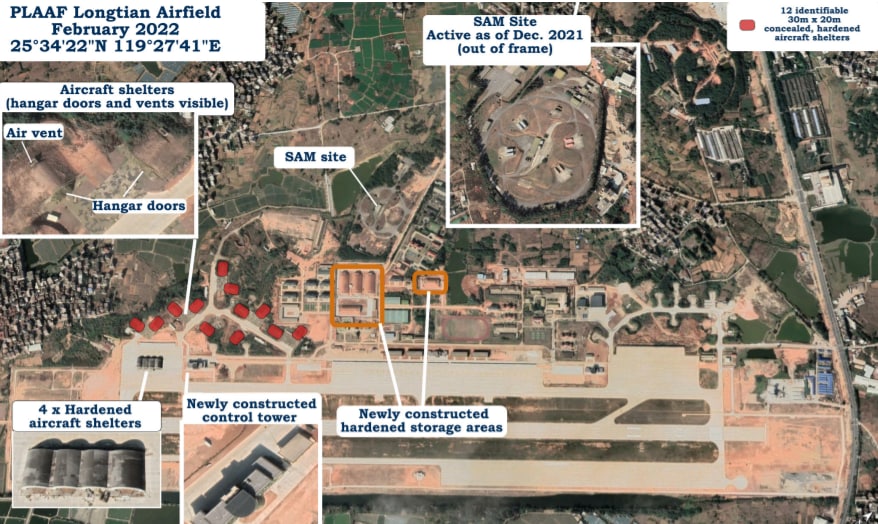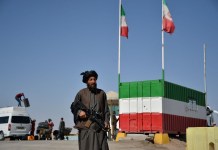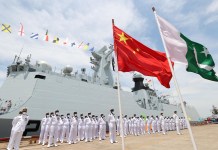A report by the Mitchell Institute for Aerospace Studies (MIAS) identifies five forward airfields China could use to launch Unmanned Combat Aerial Vehicle (UCAV) swarms against Taiwan.
Legacy aircraft converted into drones (J-6, J-7, J-8) have been concluded to be pressed in as a part of the initial wave of attacks to soften Taiwanese air defenses.
Les vieux J-6, toujours en service actif, mais plus vraiment comme avant…#Drone #Kamikaze pic.twitter.com/QdEJRr7dA5
— East Pendulum (@HenriKenhmann) October 19, 2021
These highly developed and defended airfields with hardened airfields can then be taken over by People’s Liberation Army Air Force (PLAAF) Su-30MKK, J-16, or J-10 fighters for sustained operations against Taiwan.
The distinction of this airfield is the total of 126 concealed, buried, camouflaged, and hardened shelters to station both UAVs and regular combat aircraft.
While the report calls for suppressing these airfields early in a Chinese military intervention in Taiwan, it notes that the United States Air Force (USAF) lacks the range, technological and logistical capability to do so.
The study by Daniel Rice, a non-resident fellow at MIAS, goes on to study each airfield’s satellite photo by zooming in on structures and facilities like surface-to-air (SAM) defenses existing and under-construction shelters, hangars, ammunition storages, and types of aircraft parked to draw its inferences.
The Forward Airfields
The five airfields are Shuimen, Longtian, Luocheng/Huian, Zhangzhou, and Shantou. Shuimen, Longtian, Luocheng/Huian, and Zhangzhou airfields are located within the Chinese Fujian province, and Shantou is in the Guangdong province.
Four airfields fall under the Eastern Theatre Command, the theatre command primarily responsible for Taiwan and the East China Sea.
The fifth airfield, Shantou, falls under the Southern Theatre Command but could support operations against Taiwan in the event of a conflict.

Shuimen Airfield is perhaps the most exciting and highly equipped of the four, known to house J-10 and Su-30MKK fighters along with UCAVs. It also has an S-300 or HQ-9 surface-to-air missile (SAM) battery at the airfield.
These airfields are generally guarded by HQ-9 and S-300 SAM systems. While Su-30MKKs and J-10s have been known to operate from Shuimen, Zhangzhou has J-7s and J-10s.
Longtian and Shantou have the J-6 and J-7 unmanned combat aerial vehicles (UCAV), with the latter expected to operate the KJ-500 airborne early warning and control (AEWC).

‘Drone Swarming’ Platforms
But it was the report’s belief about the possible use of Q-5, J-6, J-7, and J-8 legacy aircraft-turned drones to overwhelm Taiwanese air defenses, which is fascinating. Drones are relatively cheaper than manned planes and can bear a load of routine tasks, freeing up the costlier fighters for complex missions.
Converting legacy aircraft into UAVs is even cheaper and has multiple benefits like retaining a significant portion of their original combat capabilities and flight characteristics; reducing human casualties; being expendable; and, because of being unmanned, are not constrained by human fatigue. Likewise, by being unmanned, their maintenance cost is low, and the pilots don’t require persistent flying to maintain their level of training.
China, having manufactured these aircraft since the 1950s, is also proficient with the industrial and technical processes to upgrade and maintain them.
It does not have to rely on foreign original equipment manufacturers (OEM). Their primary battlefield utility lies in the Suppression of Enemy Air Defense/Destruction of Enemy Air Defense (SEAD/DEAD) operations to overwhelm and knock out Taiwanese SAM sites, reducing the risk to its frontline fighters.
The author expects the drones to be the first line of attack preceding the frontline fighters for both SEAD/DEAD and counter-air missions. The latter can be armed with PL-2, PL-5, PL-7, PL-8, PL-9, K-13, and Magic R-550 air-to-air missiles.
During SEAD and DEAD operations, many such UCAVs present a dilemma to the defenders to either engage the aircraft or risk losing other military assets if they are not shot down.
Calling it the Cicada strategy, the paper notes how “the PLAAF could choose to hide a large number of these UCAVs in underground shelters and have them surreptitiously emerge in mass for an attack on Taiwan.”
Naturally, either outcome benefits Chinese commanders, who will just fill the forward bases with the more modern Generation 4++ fighters if the UCAVs are shot down. If the drones are shot down, it implies Taiwan has had to burn through its stockpile of SAMs and anti-air ammunition.
Take Out the Airfields First!
The hardened underground shelters and SAM sites will protect the airfields and the planes – assuming Taiwan or the US can even land munitions on the Chinese mainland.
The swarming would also include thousands of boats (both civilian and military), missiles, UAVs, and other aircraft. This strategy has repeatedly handed devastating defeats to US and Taiwanese forces in Pentagon-commissioned war games by the RAND Corporation.
The report strongly suggests targeting these airfields first in the outbreak of war but notes that the US military lacks airborne delivery platforms and long-range stand-off munitions that can penetrate and survive the PLA’s Integrated Air Defense System (IADS).
“Although many combinations of platforms and munitions could suppress these airfields, the US Air Force currently lacks capacity in both delivery systems and munitions,” Rice said.
- The author can be reached at satamp@gmail.com
- Follow EurAsian Times on Google News




